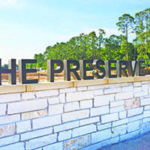This is the ninth in a series of articles that celebrate the lives of the Nobel Prize laureates whose names grace the 125 streets of Laureate Park. Dr. Costas Efthimiou, professor of physics at the University of Central Florida, contributed to this article.
“Three quarks for Muster Mark!”

In the mid-1960s, as American physicist Murray Gell-Mann set out to devise the equivalent of a periodic table for elementary particles, he cast about for an appropriate name for those particles with the most mass. For this purpose, Gell-Mann had discarded ancient Greek, the usual go-to source for scientific neologisms, as some terms invented from that language concealed unfortunate flaws. Atoms, from the Greek word for “indivisible,” were later found to be composed of smaller components and in fact were quite divisible, explosively so in some cases. These smaller components, a set of particles that physicists had just begun to discover, required a name. A nonsense word, Gell-Mann thought, would be best, a term not later to be revealed as inapt. So he turned to that singularly bountiful collection of nonsense vocabulary – James Joyce’s Finnegans Wake – discovered Muster Mark’s quarks, and assigned that moniker to three particles in his draft table, assumed to be constituents of heavier known particles, a table later to evolve into the “Standard Model of Particle Physics.” A fourth quark was discovered soon after.
We don’t often think about quarks. But we should since we are made up of them completely from head to toe. And, as far as we know, so is just about everything everywhere throughout the universe. Molecules and atoms, yes, we can more or less understand. Each atom, as we know, contains an infinitesimally tiny nucleus, ten thousand times smaller than the cloud of electrons overhead, making 99.9999999% of every atom empty space. That fact is already counterintuitive, but when we drill down further, say, into the nucleus of the atom, we enter the realm of elementary particles, where things get really bizarre. According to the Standard Model, elementary particles are of two types: bosons and fermions. Fermions make up the matter around us. The important fermion is the electron with which we are already familiar. Quarks are fermions, too. Among other duties, bosons carry the forces that hold together quarks inside protons and neutrons, from which quarks the building blocks of nuclei can never escape and never detach from one another. (Three quarks in every proton and neutron, as James Joyce accidentally predicted.) But how else to describe quarks?
Quarks have an electrical charge, expressed by a fraction, as well as a specific “spin” (also a fraction), which is not the rotational motion that we experience in our world, but rather a fundamental property that cannot really be explained. Quarks also have something called color charge, which – unfortunately for those of us trying to grasp the concept – has nothing to do with color. Every quark has a twin, an antiquark, just like in the Bizarro world in Superman comics. And through the weak force, one “flavor” of quark (yes, physicists adopted the designation “flavor” rather than “type” to further confuse us) can turn into another flavor of quark.

It was into this weird world of quarks that young Toshihide Maskawa was drawn as a student at Nagoya University, west of Tokyo. Maskawa’s first name, Toshihide, which roughly means “clever hero,” presaged his brilliance as a theoretical physicist. In grad school, Maskawa, needing a topic for an academic paper, came across an article about a phenomenon that puzzled physicists: the breakdown of symmetry in both the charge of particles and the parity of their spatial coordinates in the formation of antimatter. This breakdown of symmetry is known as “CP Violation” – the C standing for “charge” and the P for “parity.” (Antimatter particles, including antiquarks, are not science fiction but quite real, and a slight surplus of matter over antimatter following the Big Bang, a result of CP Violation, left us with a universe containing matter – including ourselves.) The problem confronting Maskawa was that the four-quark model and CP violation were mathematically incompatible. Working with his colleague, Makoto Kobayashi, Maskawa attacked the problem, which seemed insolvable until one evening, stepping out of his bath, he hit upon the answer: The universe contained six quarks, not four! Unlike the ancient Greek philosopher Archimedes, Maskawa did not leap out of the tub to run through the streets of town shouting “Eureka” to announce his breakthrough to the world, but his discovery was no less momentous for science. To the already known and named up, down, strange, and charm quarks, Maskawa and Kobayashi in 1978 postulated the existence of two more quarks to be discovered years later at Fermilab near Chicago and dubbed the top and bottom quarks. For this achievement, the duo won the 2008 Nobel Prize in physics, shared with their compatriot Yoichiro Nambu. In December of that year, Maskawa traveled to Stockholm to accept his award, thus making, at age 68, his first trip outside of Japan.
Twelve years earlier, while spending two weeks in Dublin on a business trip, I convinced an Irish cousin of mine to make a visit one Saturday to the James Joyce Museum in a small row house in that city. As we ascended to the second floor of the residence, an elderly gentleman poked a book into our faces and announced, “This is the Japanese translation of Finnegans Wake.” Our man, it turned out, was Joyce’s nephew. In the ensuing conversation, one common thought baffled the three of us: how could a 625-page novel of purposely invented nonsense words ever be translated into any other language, a paragraph of which even English speakers struggle mightily to decipher? We now know, though, that nonsense words sometimes acquire concrete meanings, and what noun could be more meaningful than that which refers to the basic building blocks of all matter in the universe? A new generation of Japanese physicists, building upon the legacy of Toshihide Maskawa and his contemporaries, may one day need to coin new terms for their future discoveries, for example, for the vibrations of the strings in string theory that form fermions and bosons – if those vibrations are ever observed. For that purpose, they will surely need look no further than to that universally acclaimed masterpiece, Fineganzuu eiku, by that famed Hibernian author, Jēmuzu Joisu.

Next month: Gabriela Mistral, A Peripatetic Poetess, or Una Poetisa Itinerante
Dennis Delehanty moved to Laureate Park with his wife, Elizabeth, from the Washington, D.C., area in mid-2018. Dennis completed a long career in international affairs at the U.S. Postal Service, the United Nations and the U.S. Department of State, jobs that required extensive global travel and the acquisition of foreign languages. You can contact Dennis at donnagha@gmail.com.


